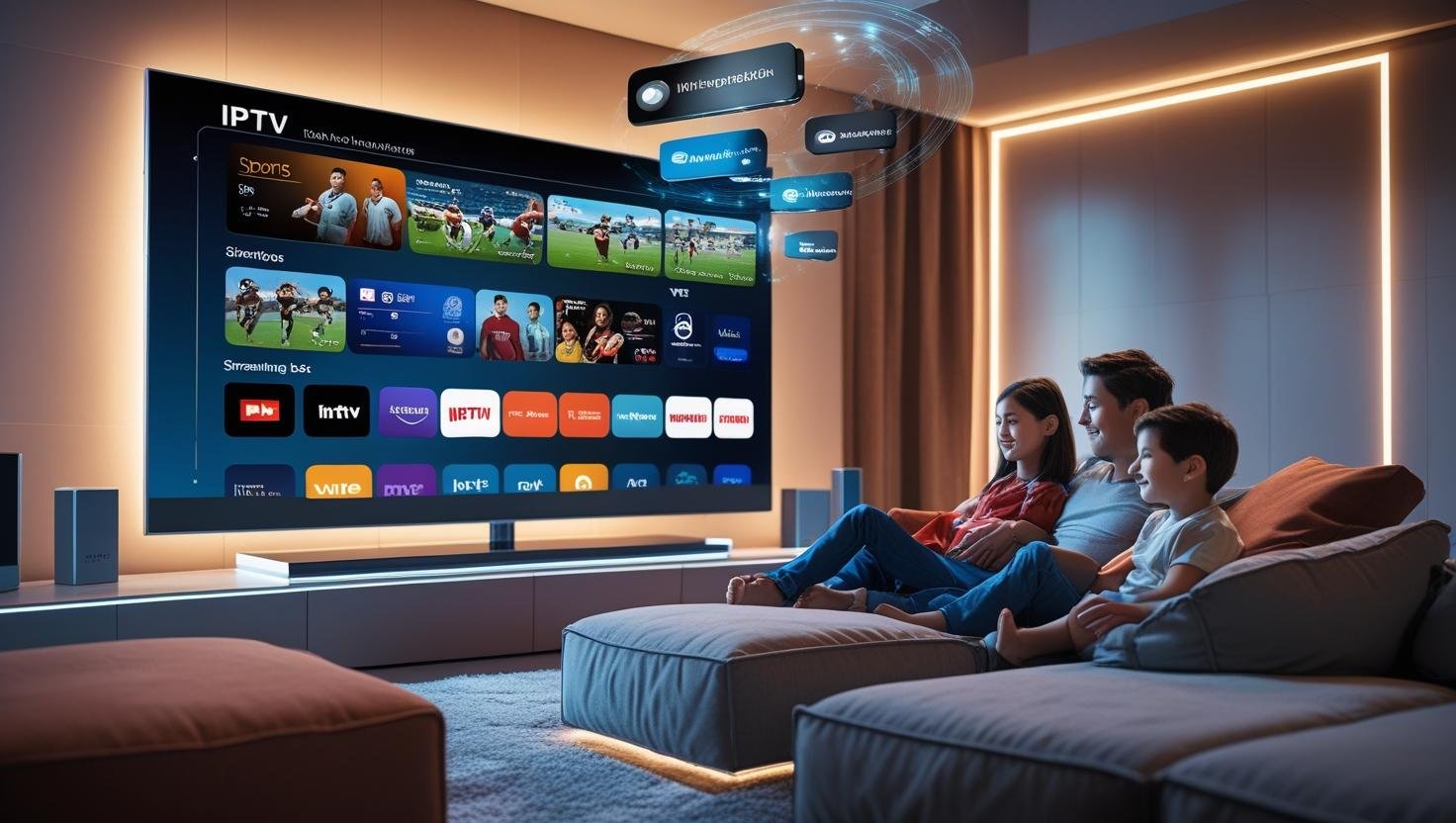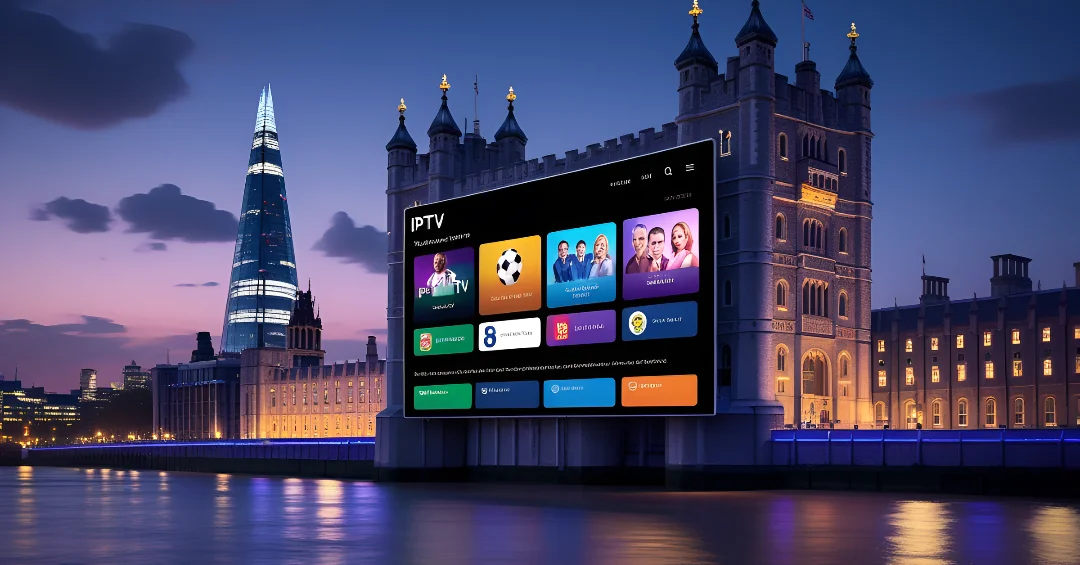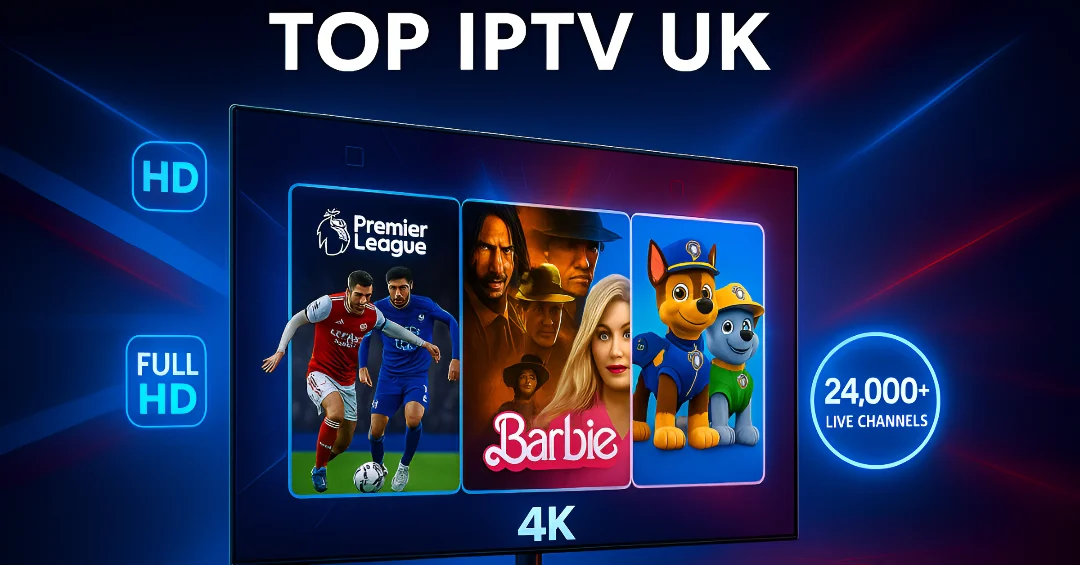IPTV (Internet Protocol Television) has gone from niche to mainstream in the UK. But with dozens of providers, wildly different offers, and a swirl of acronyms—EPG, M3U, VOD, Xtream Codes—it’s tough to know what’s fair, what’s fluff, and what’s a red flag. Best IPTV Deals in UK.
This guide breaks down IPTV UK pricing and packages in plain English, so you can compare like-for-like, avoid gotchas, and land the best deal today—legally, safely, and sensibly.
1) IPTV Pricing 101: What You’re Really Paying For
The Three Big Levers
- Time commitment
- Monthly (30 days): highest effective price, low commitment.
- Quarterly (90 days): mid-price, manageable commitment.
- Annual (12 months): lowest per month; only sensible after testing reliability.
- Concurrency (streams at once)
- Plans often include 1–4 simultaneous streams.
- Each extra stream costs more. Don’t pay for four if your home uses two.
- Content scope
- UK Freeview, BBC/ITV/Sky-adjacent channels, sports (Premier League, F1, boxing), films, international packs.
- Some providers sell bundles (e.g., Sports + Movies) or all-in options. The more you pack in, the more it costs.
Typical Price Ranges (2025, UK market snapshots)
- Basic (UK + core entertainment): £10–£15/month
- Sports-heavy (more 50/60fps channels, wider coverage): £15–£20/month
- All-in (wider international + premium VOD): £18–£25+/month
- Annual equivalents: often 15–30% cheaper per month than monthly
Pro tip: Ignore mega channel counts (“20,000+”) as a value metric. Quality and stability beat raw quantity.
2) The “Total Cost of Streaming” (TCS) Formula
Use this to budget realistically: Best IPTV Deals in UK .
TCS = Subscription + (Optional) App Licence + (Optional) VPN + One-off Network Tweaks
- Subscription: the IPTV plan itself.
- App licence: e.g., TiviMate Premium (once per year or lifetime), some desktop players are free (VLC).
- VPN: optional; can aid privacy/routing—but may reduce speed if misconfigured.
- Network tweaks: £10–£30 for a USB-to-Ethernet adapter, £50–£200 for a Wi-Fi 6 router or mesh node if your home needs it.
Example Budgets
Value seeker (single stream, HD focus)
- Monthly sub: £12
- App: £0 (VLC)
- VPN: £0
- Ethernet adapter: £15 (one-off)
- Month 1 total: £27, then ~£12/month
Sports household (2 streams, 4K-capable)
- Monthly sub: £18
- App: £8/yr (amortised ~£0.67/mo)
- VPN: £3–£6/mo (optional)
- Router upgrade: £120 (one-off; only if needed)
- Month 1: £141–£144, then ~£22–£25/month (sub + VPN + app amortised)
-
Best IPTV Deals in UK
3) Package Types Explained (And How to Compare Them)
A) Monthly vs Quarterly vs Annual
- Monthly: try before you commit; perfect for stress-testing Fridays (sports) and Sunday evenings (catch-up).
- Quarterly: smart middle ground; reduces admin and saves 10–15%.
- Annual: best price only if the service has proven reliable for you.
B) Streams / Screens
- 1 stream: solo user or a couple who rarely watch at the same time.
- 2 streams: typical family (lounge + bedroom).
- 3–4 streams: flat-shares, larger families.
- Rule: buy for peak usage, not average.
C) Resolution & Frame Rate
- HD (1080p) with 50/60fps for sports is a must if you care about motion.
- 4K/HLG/HDR10/Dolby Vision: premium tiers + robust broadband (25–50 Mbps per stream).
D) VOD & EPG Quality
- EPG: look for accurate schedules, quick zapping, and usable categories.
- VOD: recent films/series, working subtitles, reliable audio tracks, decent search.
E) Device Compatibility
- Fire TV Stick (4K/4K Max), Android TV/Google TV boxes, Smart TVs, mobiles, PCs.
- Good iptv providers support multiple app types and give clear setup docs.
4) How Much Speed Do You Need? (Per Active Stream)
- SD (480p): 3–5 Mbps
- HD (720p/1080p): 10–25 Mbps
- 4K (2160p): 25–50 Mbps
- Live sports 50/60fps: aim for the top of each range
Add headroom for other home usage (WFH calls, gaming, downloads). Three concurrent 1080p streams? Budget 30–60 Mbps just for TV.
5) Legal & Safety Basics (Read This)
- IPTV is a delivery method, not a licence.
- Choose providers operating within applicable laws, with rights to the channels/VOD they sell.
- Avoid services that blatantly market copyrighted content without permission.
- A VPN can add privacy and sometimes smooth routing; it does not confer content rights.
If licensing certainty matters (e.g., premium sport), select providers that explicitly confirm authorised distribution. Best IPTV Deals in UK.
6) Red Flags & Green Flags When Shopping
Red Flags (Proceed with caution)
- “Lifetime” plans (unsustainable; often vanish)
- No trial, no monthly option, pay-by-crypto only
- Vague websites, no company contact, no support docs
- Overhyped specs (“8K everywhere”) but no proof or device requirements
- Pushy upsells, zero refund policy
Green Flags (Positive signals)
- Short paid trial or 24–48h test window
- Clear plan structure (streams, resolution, VOD, EPG)
- Setup guides for your device, responsive support (chat/email)
- Regular updates/status pages, active community/FAQ
- Transparent terms, refund/renewal policy
7) The Best Way to Buy: A Step-By-Step Playbook
- List your must-haves: UK channels, sports, films, international packs, no. of streams.
- Pick your device(s): Fire TV 4K/Max or Chromecast 4K are safe defaults; wire your main TV.
- Shortlist 2–3 providers: prioritise those with trials and proper docs.
- Trial at peak time: Friday evening sport, weekend prime time.
- Network tune-up:
- If Wi-Fi only, prefer 5 GHz.
- Enable QoS to prioritise the TV device.
-
Best IPTV Deals in UK
- App choice:
- TiviMate (Android/Fire TV) – powerful, clean
- IPTV Smarters – simple, multi-platform
- VLC – free, versatile (PC/mobile)
- Check the details: EPG accuracy, VOD stability, subtitles, audio sync.
- Upgrade smartly: If your trial is rock-solid, move to quarterly/annual for savings.
- Right-size streams: Buy exactly what you need for peak household usage.
- Calendar renewals: Avoid surprise auto-renewals; diarise your deal.
8) Sample Packages & Who They Suit
A) Budget Starter (HD, 1 stream)
- £10–£12/month
- UK + core entertainment, light VOD
- For solo viewers or couples with minimal overlap
B) Family Plan (HD/4K mix, 2 streams)
- £14–£18/month
- Better EPG, broader VOD, kids + films
- For lounge + bedroom, parents + kids
C) Sports Focus (50/60fps priority, 2 streams)
- £16–£20/month
- Higher frame rates, more sports options, catch-up
- For Premier League/F1/boxing fans
D) Global/Expats (international packs, 2–3 streams)
- £18–£25+/month
- UK + regional packages, news, multilingual EPG
- For multilingual households and expats
Tip: For students, a monthly basic plan plus occasional sports day-passes is often cheaper than a big all-in annual.
-
Best IPTV Deals in UK.
9) Negotiating & Deal-Hunting (Yes, It Works)
- Ask for bundle discounts: “Any offer if I take annual + 2 streams?”
- Time your buy: Black Friday, New Year, start of football seasons.
- Leverage trials: Demonstrate you tested peak time and are ready to commit—if they sharpen the pencil.
- Refer-a-friend: Some providers exchange referrals for credits or free months.
10) Network Optimisation = Priceless Picture Quality
- Ethernet > Wi-Fi. If wiring is impossible, try Powerline (results vary) or a mesh node near the TV.
- Wi-Fi at 5 GHz is ideal; manually select a clear channel.
- Router placement: central, elevated, away from microwaves/thick walls.
- QoS: prioritise your TV stick/box’s MAC address.
- Firmware updates: router and device.
- Household hygiene: no giant downloads during live matches.
11) Popular Players & Hidden Costs (or Savings)
- TiviMate Premium offers the greatest channel management, EPG, and several playlists for a nominal annual or lifetime cost.
- IPTV services Smarters: free + optional pro features; great for simplicity.
- VLC: free, reliable on PC/mobile; fewer TV-style niceties.
Paying £8 once for a superb player is often the best value upgrade you’ll make.
12) Comparison Checklist (Copy/Paste This)
Create a quick spreadsheet with these columns and score providers 1–5:
- Price (monthly/quarterly/annual)
- Streams included
- HD/4K, 50/60fps sports
- EPG accuracy & speed
- VOD depth & reliability
- Device support (your device!)
- Trial/refund policy
- Support quality (response time, clarity)
- Payment options (cards/paypal/bank)
- Terms transparency
Total the scores; your top two go to peak-time trials.
13) Common Problems… and Fast Fixes
- Buffering or freezing:
- Switch to Ethernet or better 5 GHz Wi-Fi
- Increase player buffer, close background apps
- Reboot router/device; update app/firmware
- Audio out of sync:
- Toggle hardware decoding; adjust AV sync in player
- Black screen / one channel fails:
- Refresh playlist, re-enter credentials
- If only one category fails, likely source-side—contact support
- EPG wrong time/missing:
- Check XMLTV source; set correct time zone and offset
- Force a full EPG reload and wait for parsing
14) FAQs: Pricing & Packages
Q1: What’s a fair monthly price for IPTV UK in 2025?
A: £10–£15 for basic/standard, £15–£20 for sports-heavy or broader bundles. Annuals often cut 15–30% off the monthly equivalent.
Q2: Should I go annual right away to save more?
A: No. Trial first in peak hours. If stability is solid for you, then step up to quarterly/annual.
Q3: How many streams do I need?
A: Buy for peak household usage. Lounge + bedroom? Likely 2. Flat-share? Perhaps 3–4.
Q4: Is 4K worth paying for?
A: On 55″+ screens and for films/sports, yes—if your line sustains 25–50 Mbps per stream and your device/TV supports it.
Q5: Do I need a VPN?
A: Optional. Can help privacy/routing, but may reduce speed if misconfigured. Try nearby servers and test with/without.
Q6: What’s the cheapest way to start?
A: Monthly basic plan + Ethernet adapter for your stick/box. If rock-solid, upgrade to annual later.
Q7: Are “lifetime” deals good value?
A: Usually not. Costs increase, services vary, and “lifetime” sometimes refers to a brief vendor lifetime.
15) Example Buyer Profiles
The Sports Fan
- Needs: 50/60fps HD/4K sport, 2 streams
- Plan: £16–£20/month, quarterly after testing
- Must-do: Ethernet to main screen; QoS on router
The Family Bundle
- Needs: Kids + films + UK channels, 2 streams
- Plan: £14–£18/month; annual if stable
- Must-do: Profiles/favourites, parental controls
The Expat/Multilingual Home
- Needs: UK + regional packs, 2–3 streams
- Plan: £18–£25+/month
- Must-do: Check language audio/subtitles, EPG localisation
The Student/Value Hunter
- Needs: Low cost, 1 stream, minimal VOD
- Plan: £10–£12/month
- Must-do: Monthly, pause during exams/holidays
16) Glossary
- IPTV subsription: TV over the internet, not satellite/cable.
- EPG: Electronic Programme Guide (TV schedule).
- M3U: Playlist file/URL containing channels.
- Xtream Codes: API/portal login used by many apps.
- VOD: Video on Demand (movies/series on tap).
- Adaptive Bitrate, or ABR, allows the player to adapt quality to your bandwidth.
- HLG/HDR10/DV: HDR formats for better brightness/colour.
- ARC/eARC: HDMI audio return to soundbar/AVR.
17) Your Action Plan: Get the Best Deal Today
- Define needs: channels, sports, VOD, streams, 4K yes/no.
- After choosing between Chromecast 4K and Fire TV 4K/Max, configure Ethernet.
- Shortlist & trial: two providers, peak-time tests, same device/network.
- Measure results: buffering incidents, EPG accuracy, VOD performance.
- Optimise network: 5 GHz channel, QoS, firmware updates.
- Choose package: right-size streams, quarterly/annual only if proven.
- Lock in savings: apply referrals, seasonal deals, bundle discounts.
18) Bottom Line
In the UK, IPTV pricing is finally predictable if you know how to compare:
- Don’t fixate on inflated channel counts.
- Do focus on stability, sports frame rates, EPG/VOD quality, and device support.
- Test first, wire your main screen, then upgrade to longer terms for the best price.
Take the measured path—trial → tune → upgrade—and you’ll enjoy smooth HD/4K streams for less, without paying for fluff you don’t use. Happy streaming!







